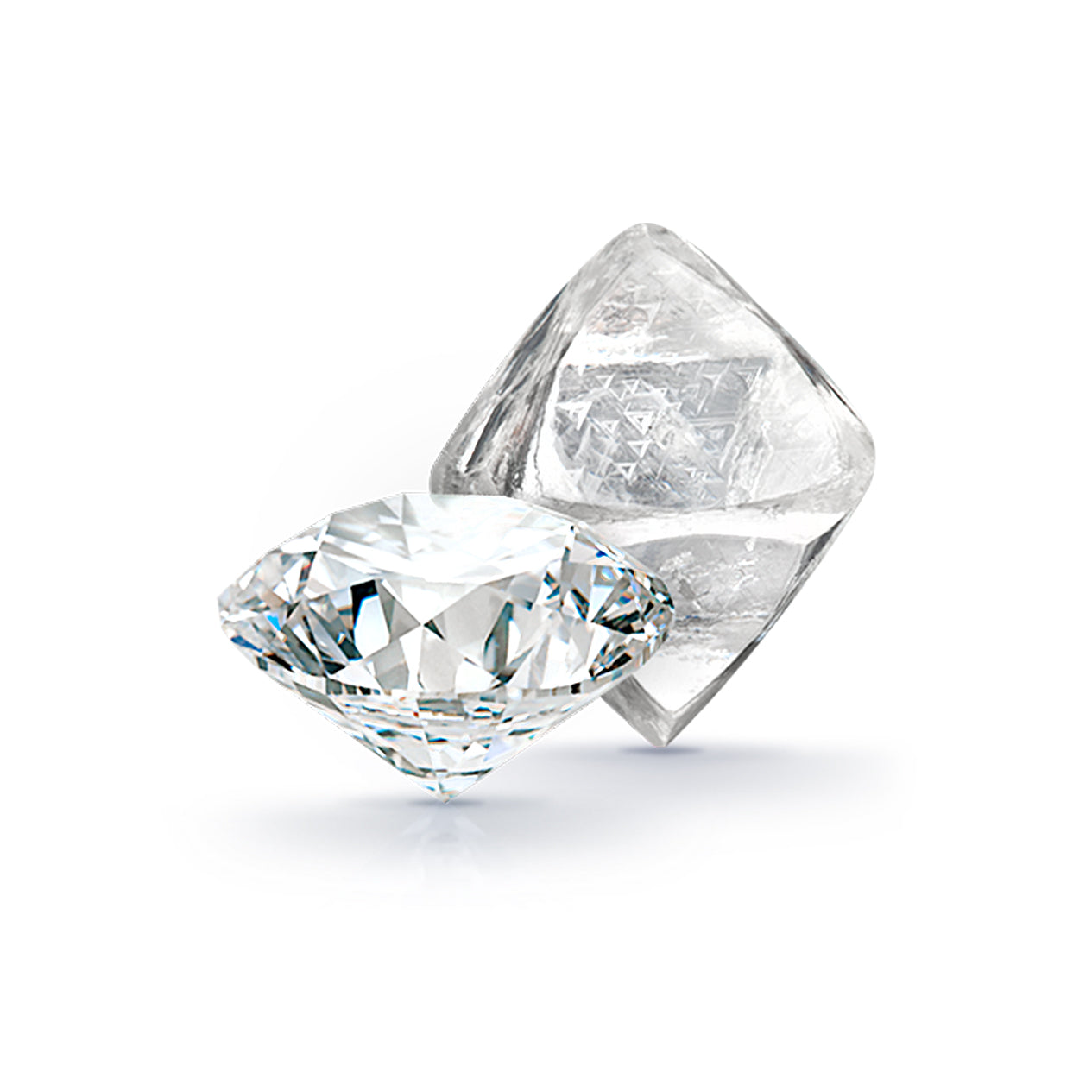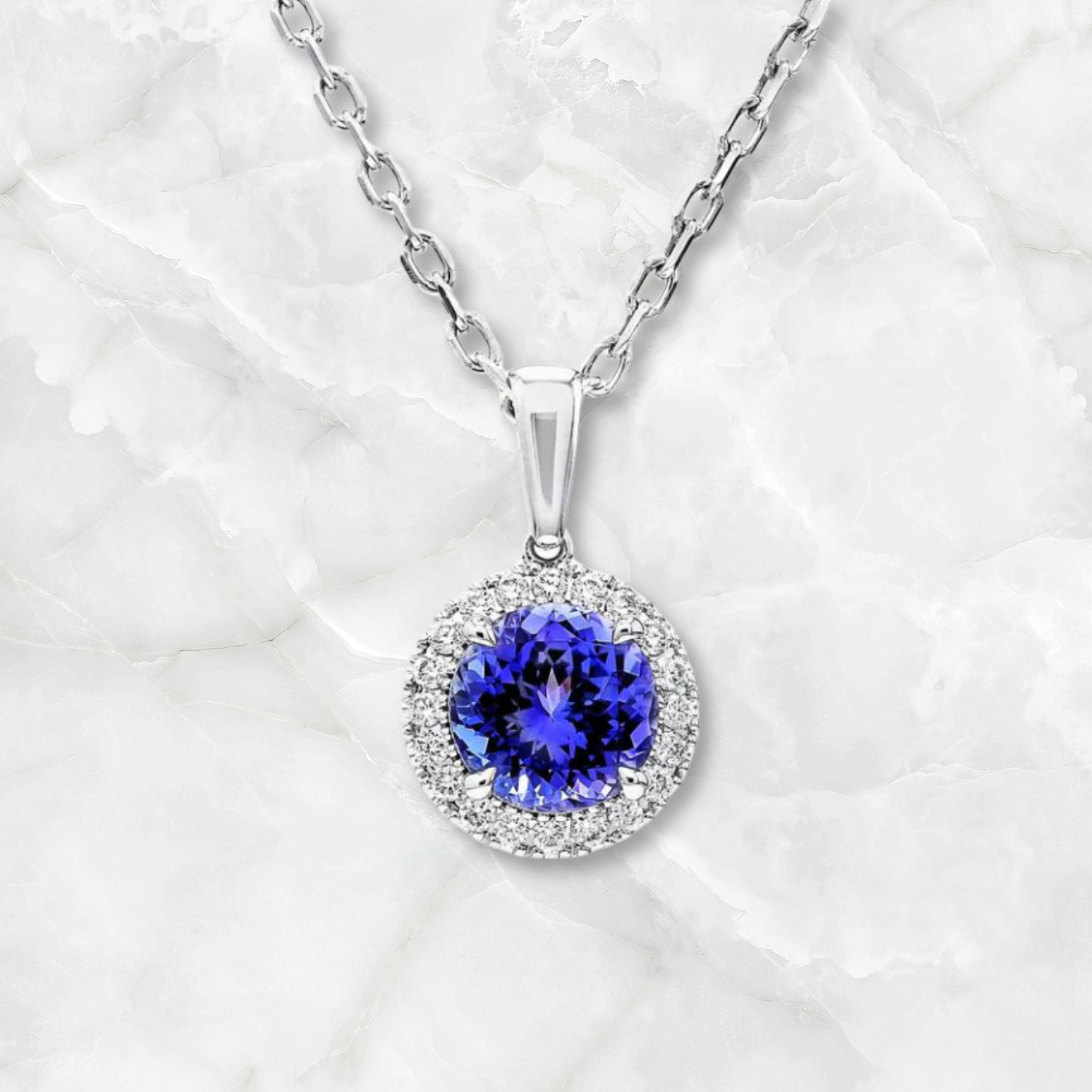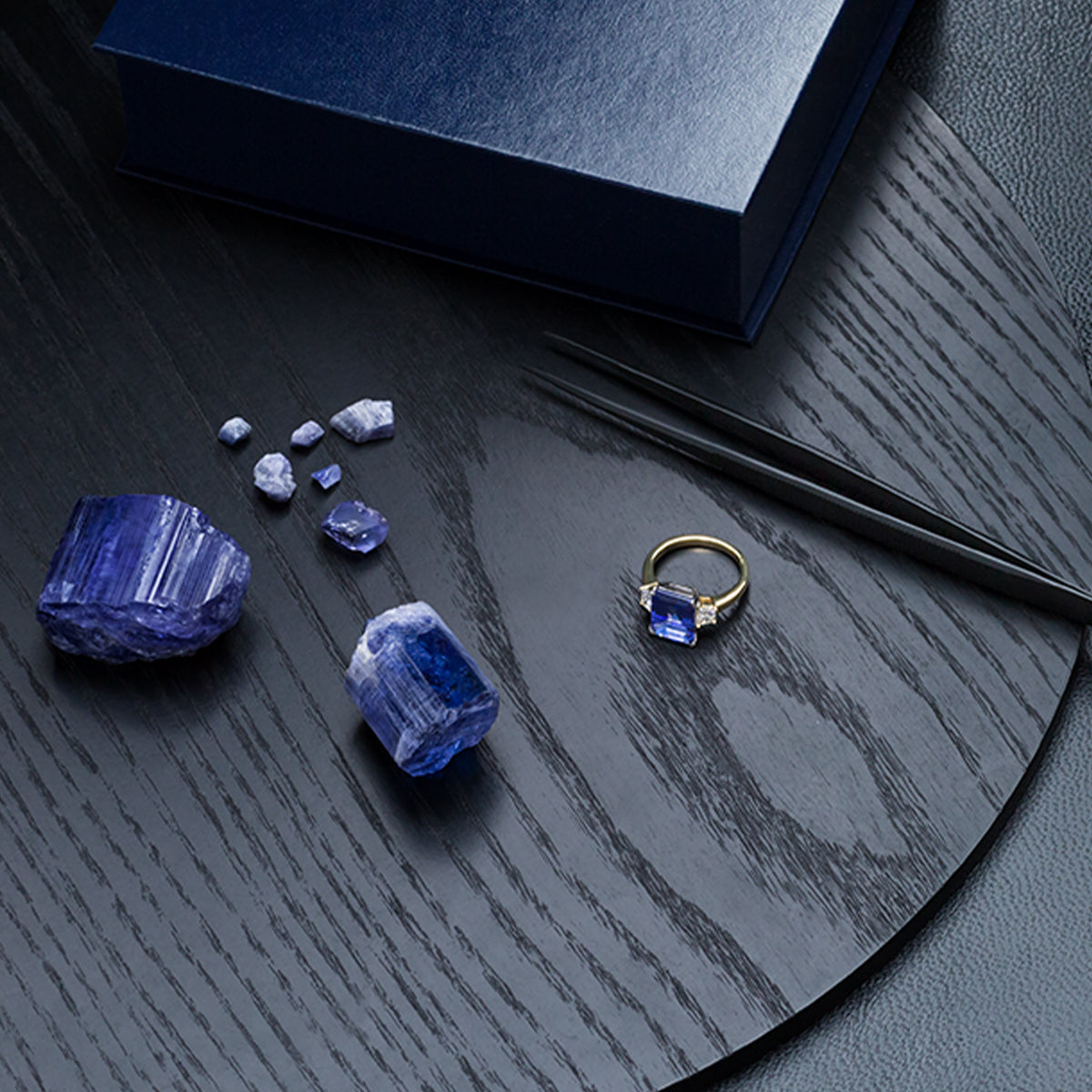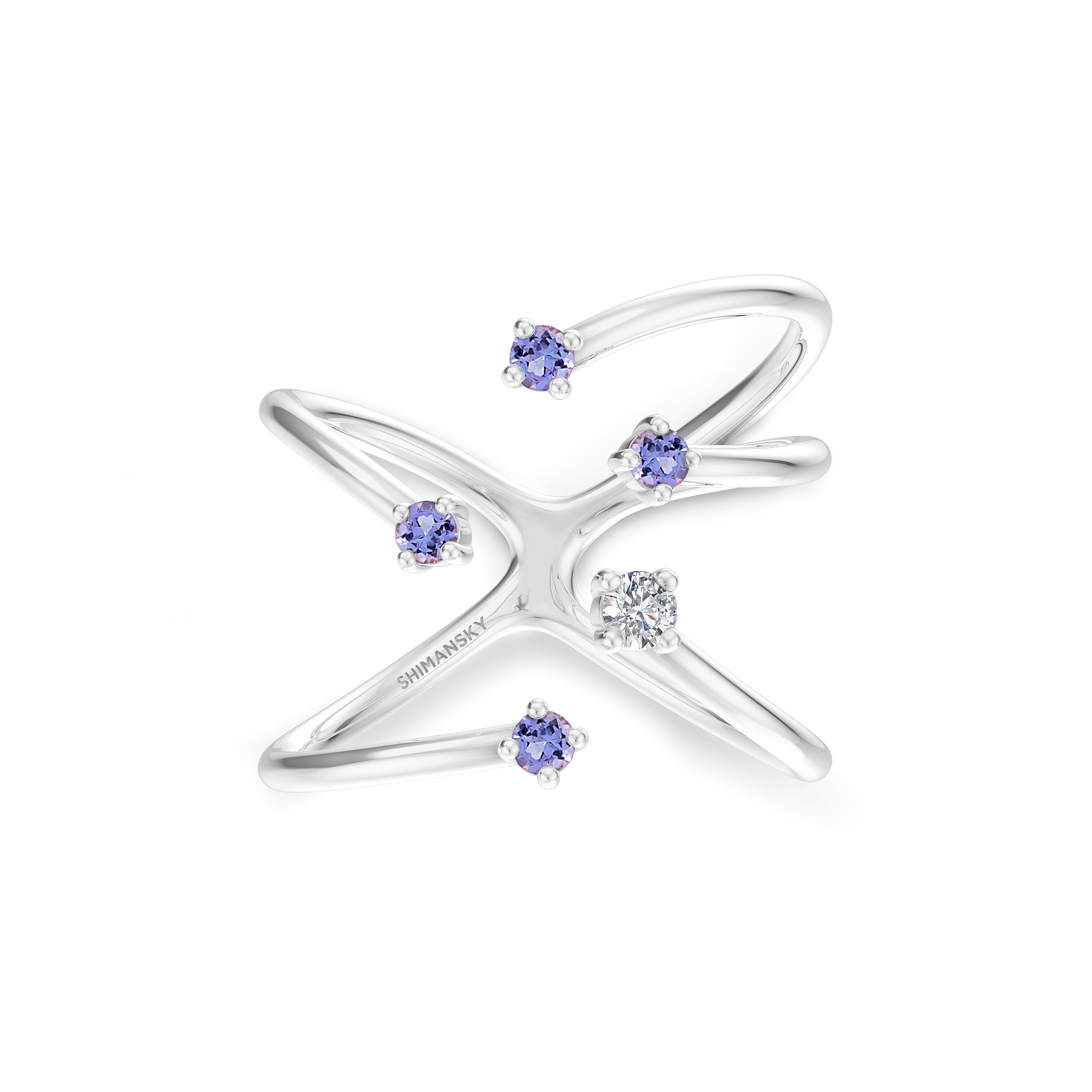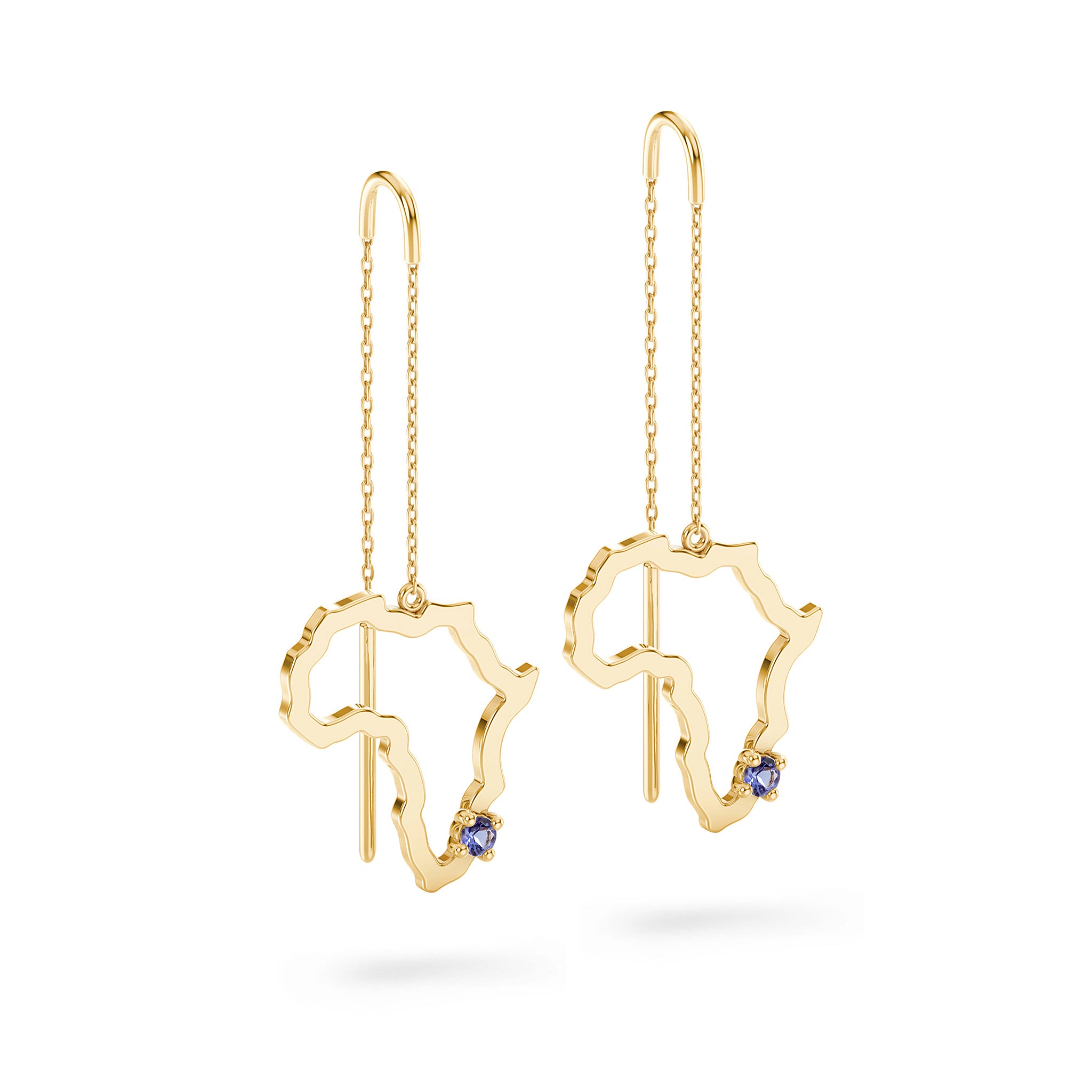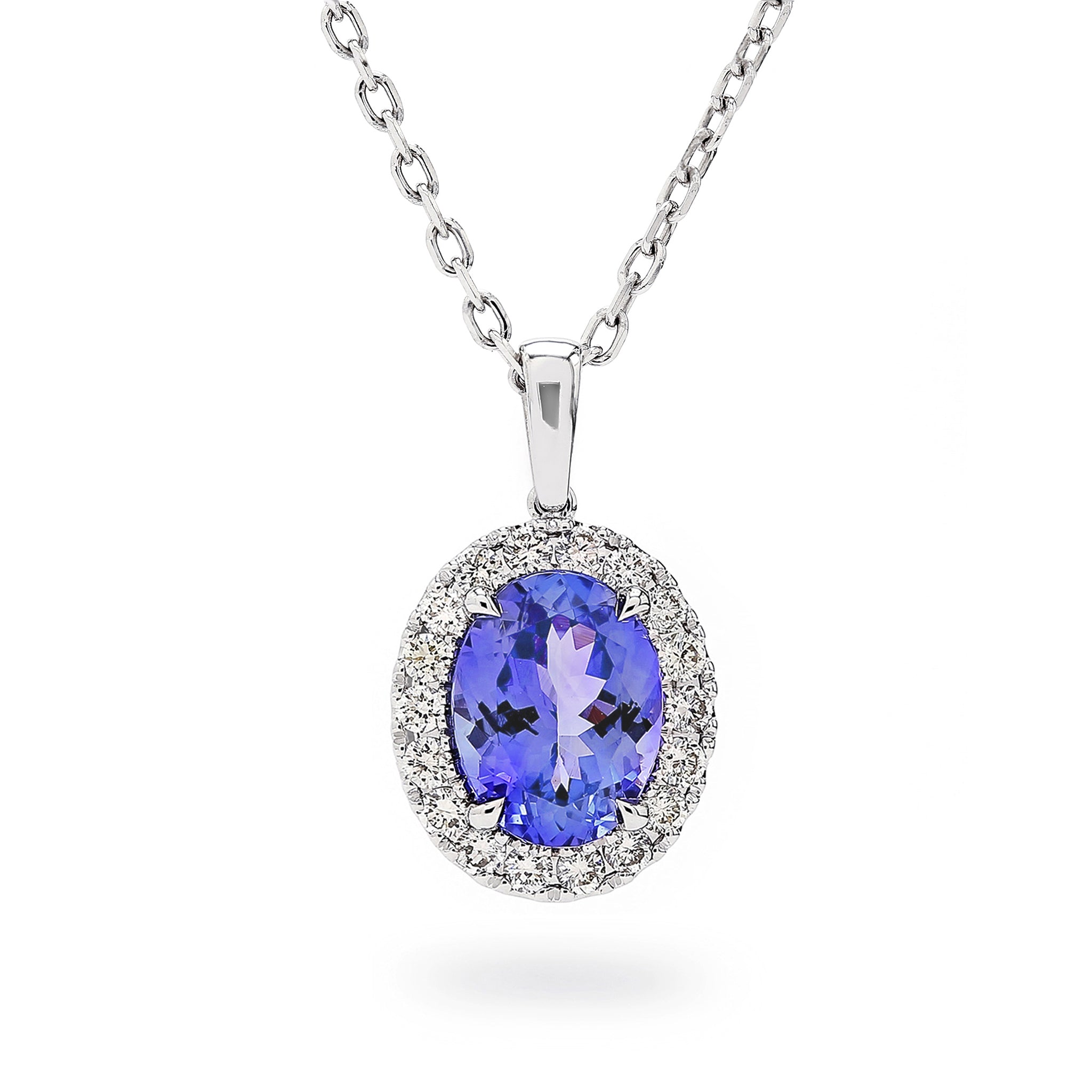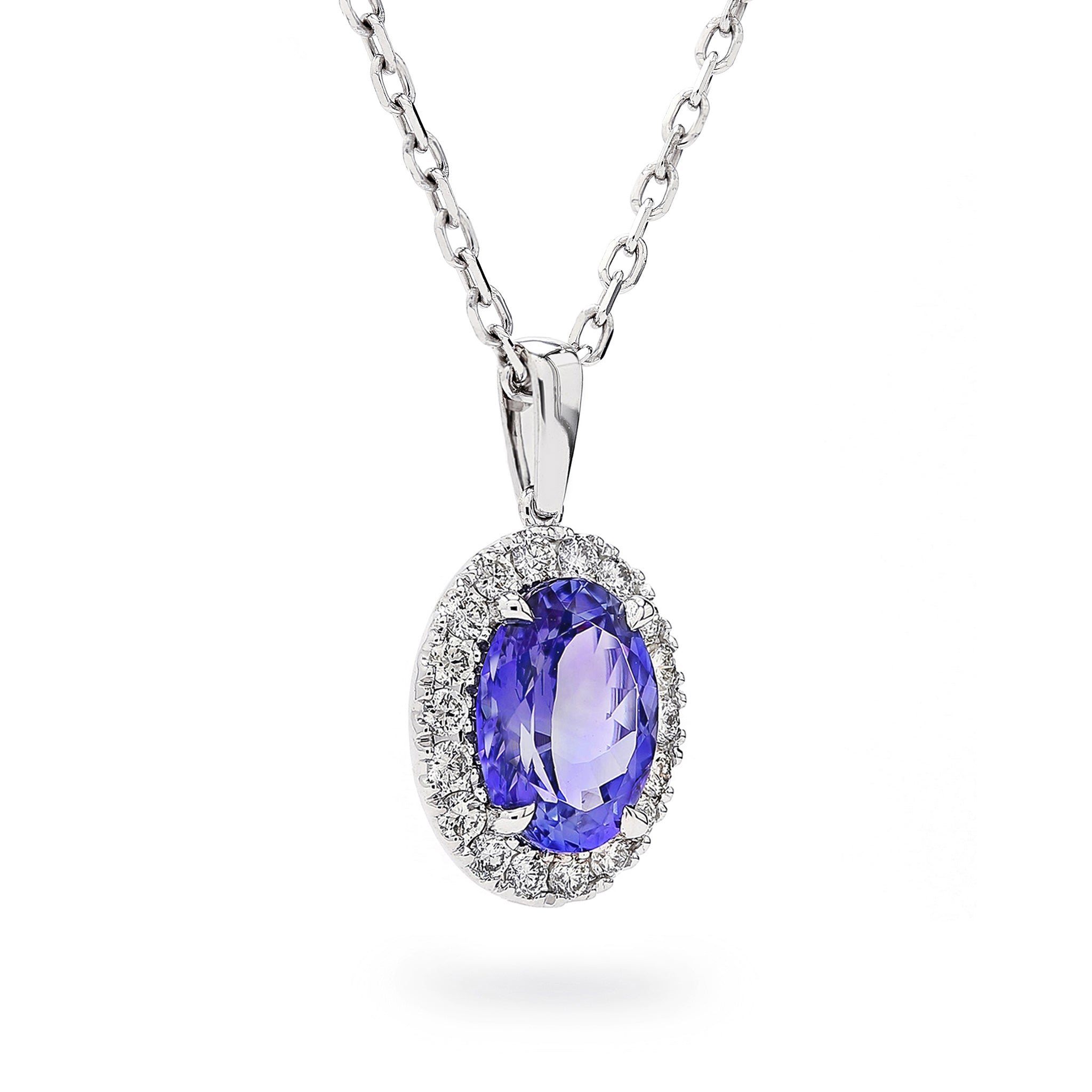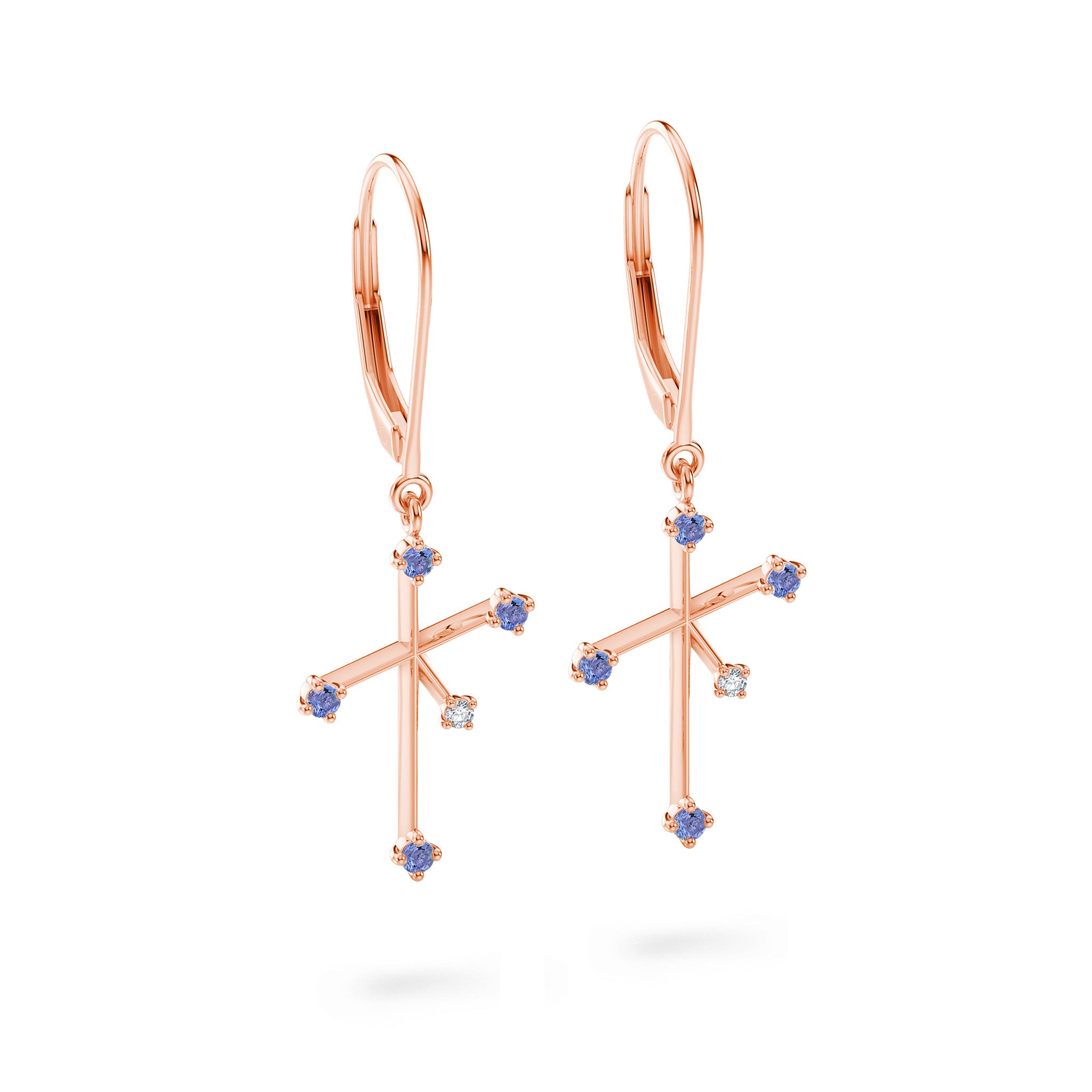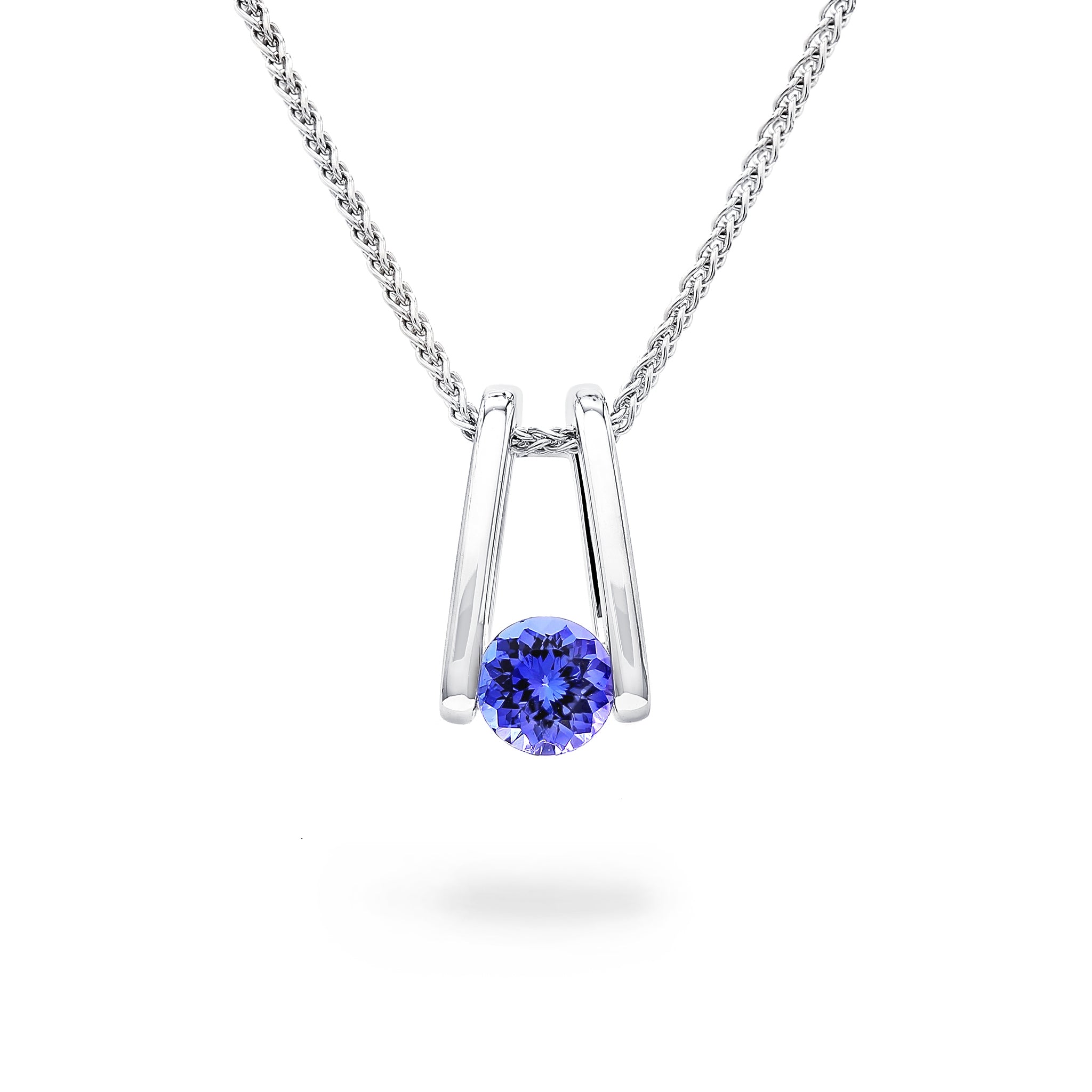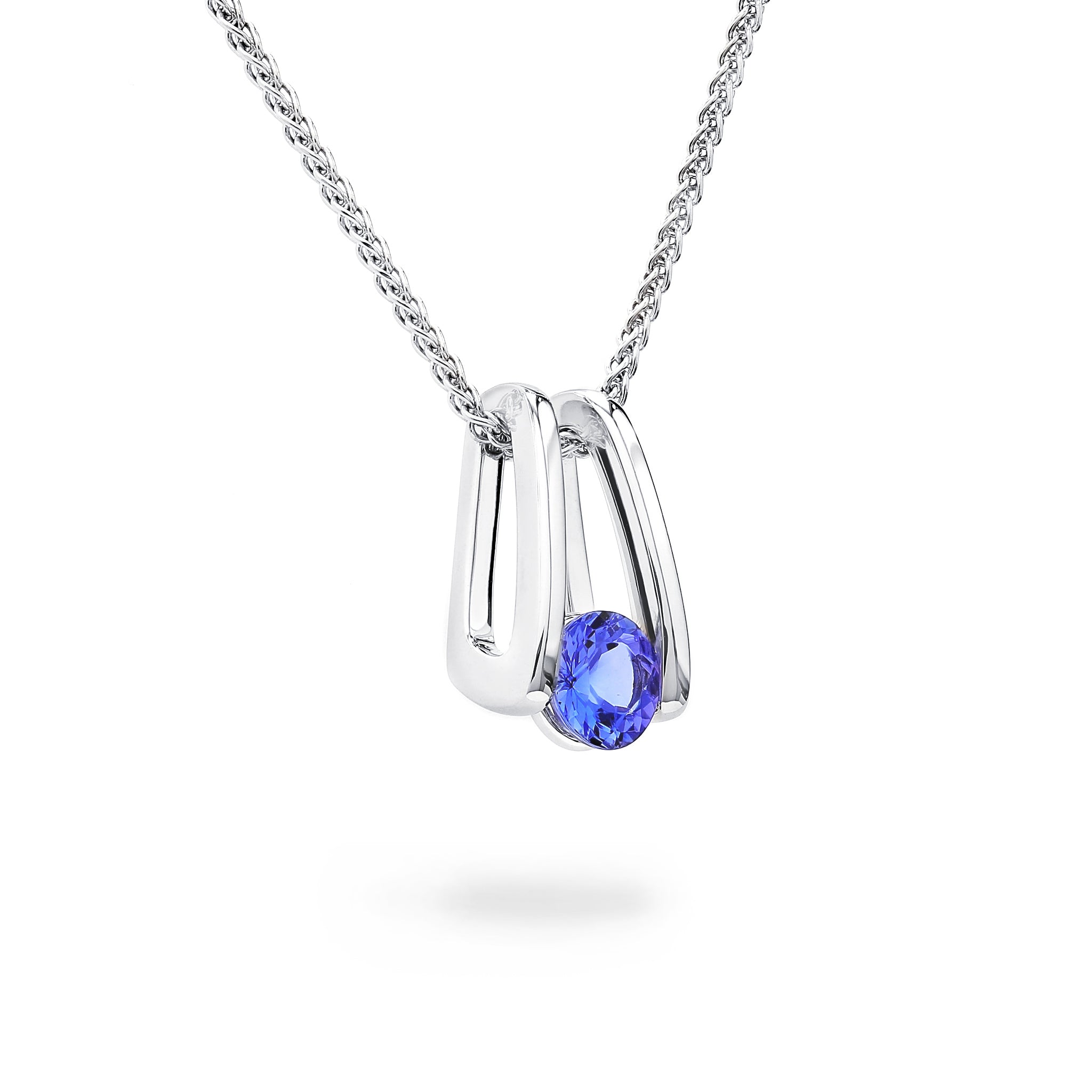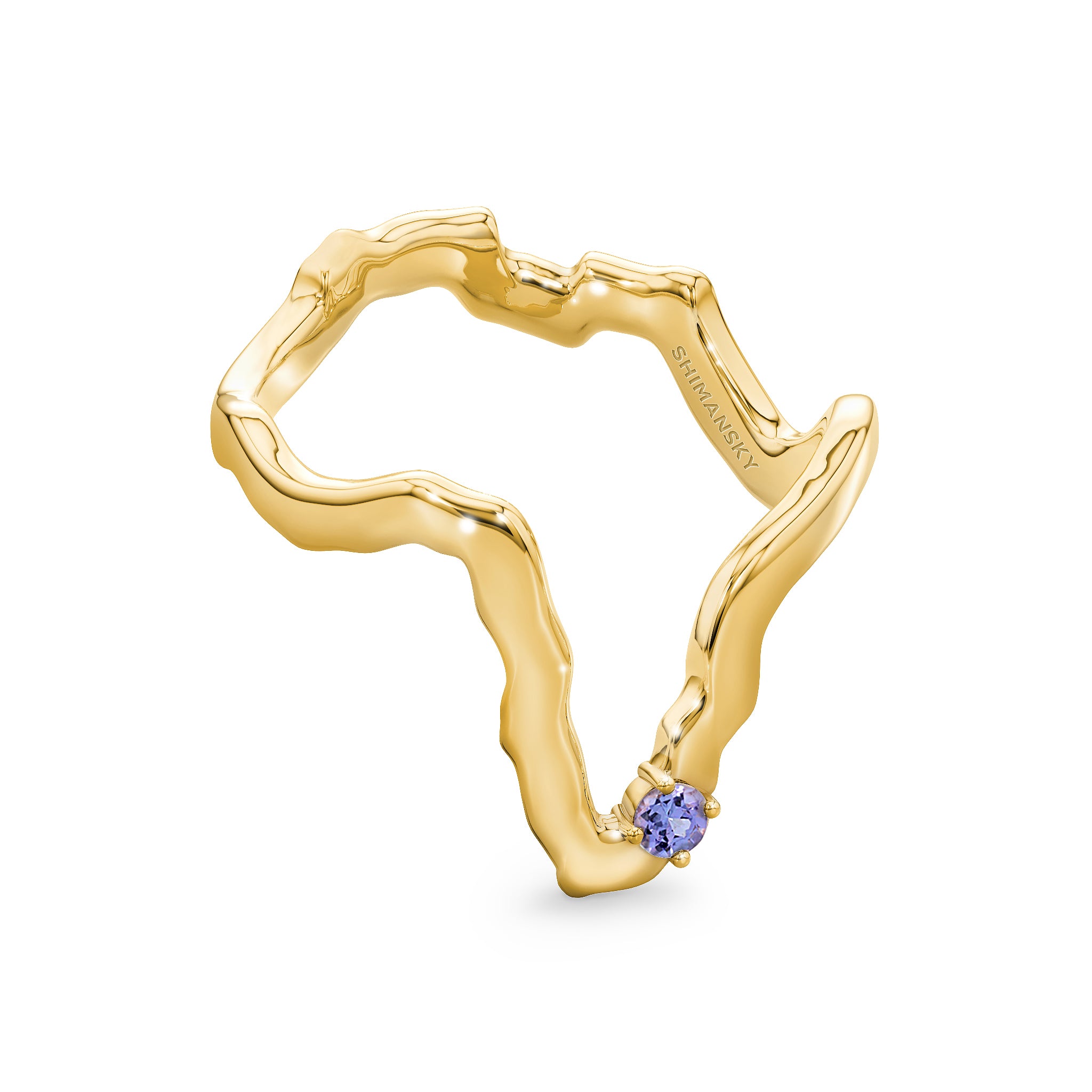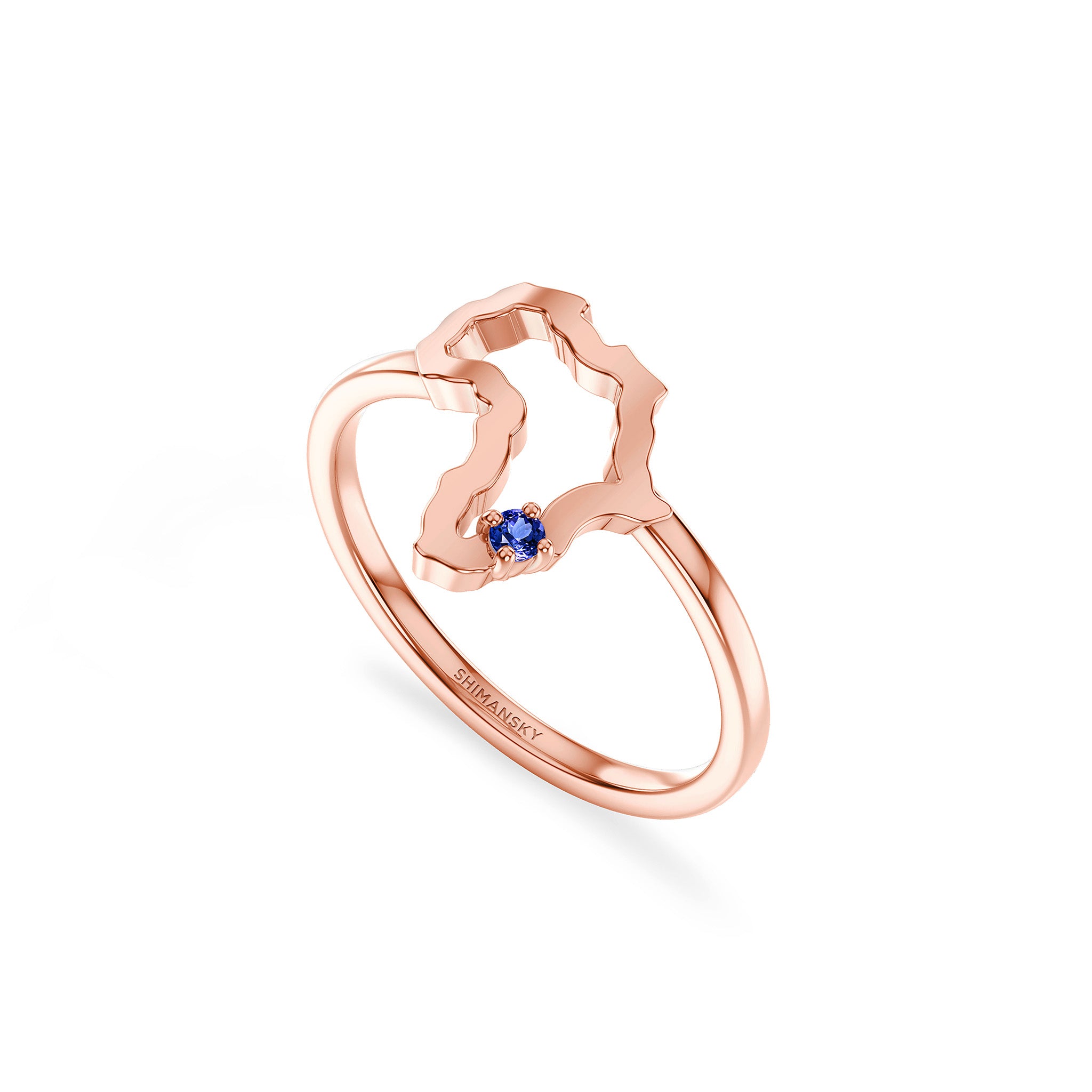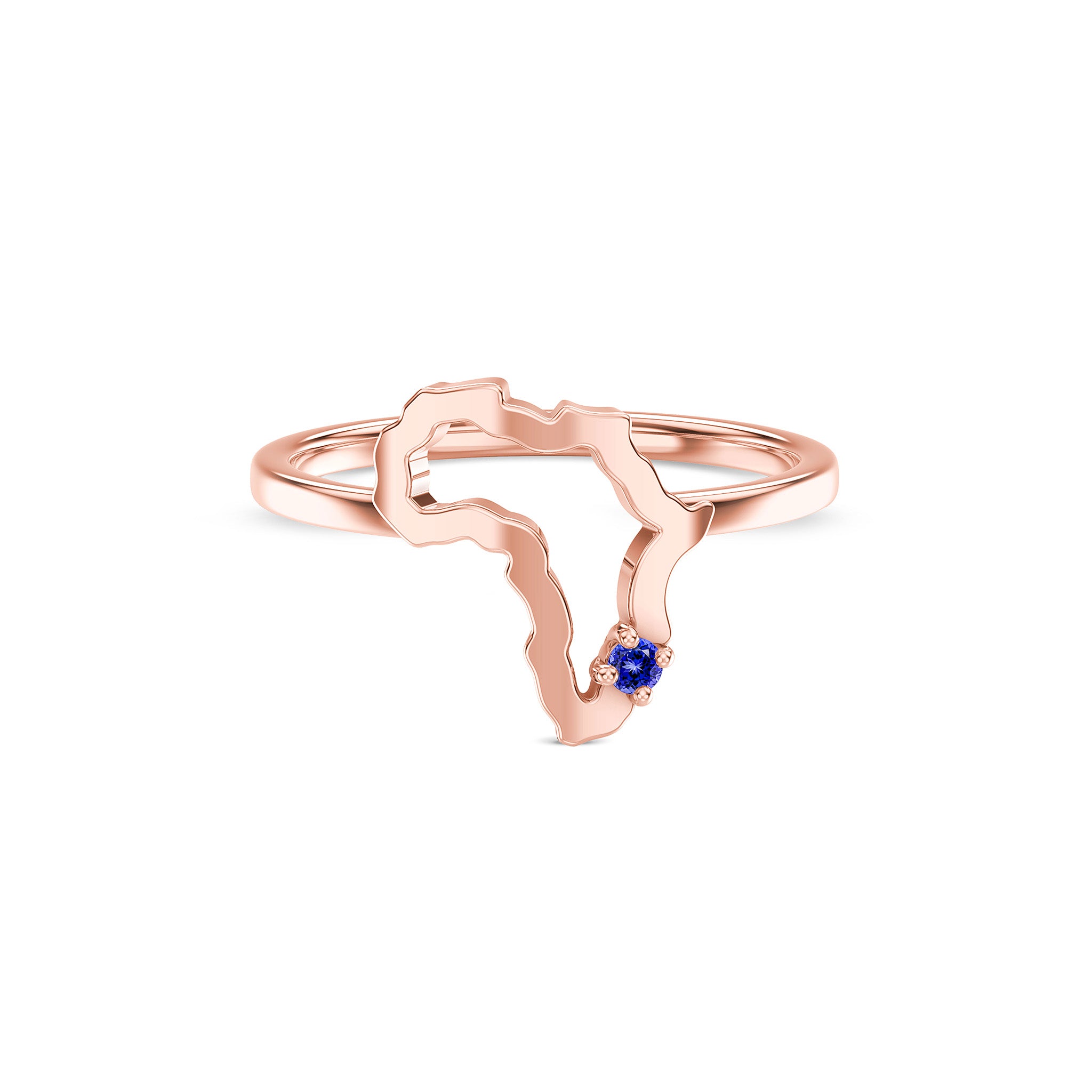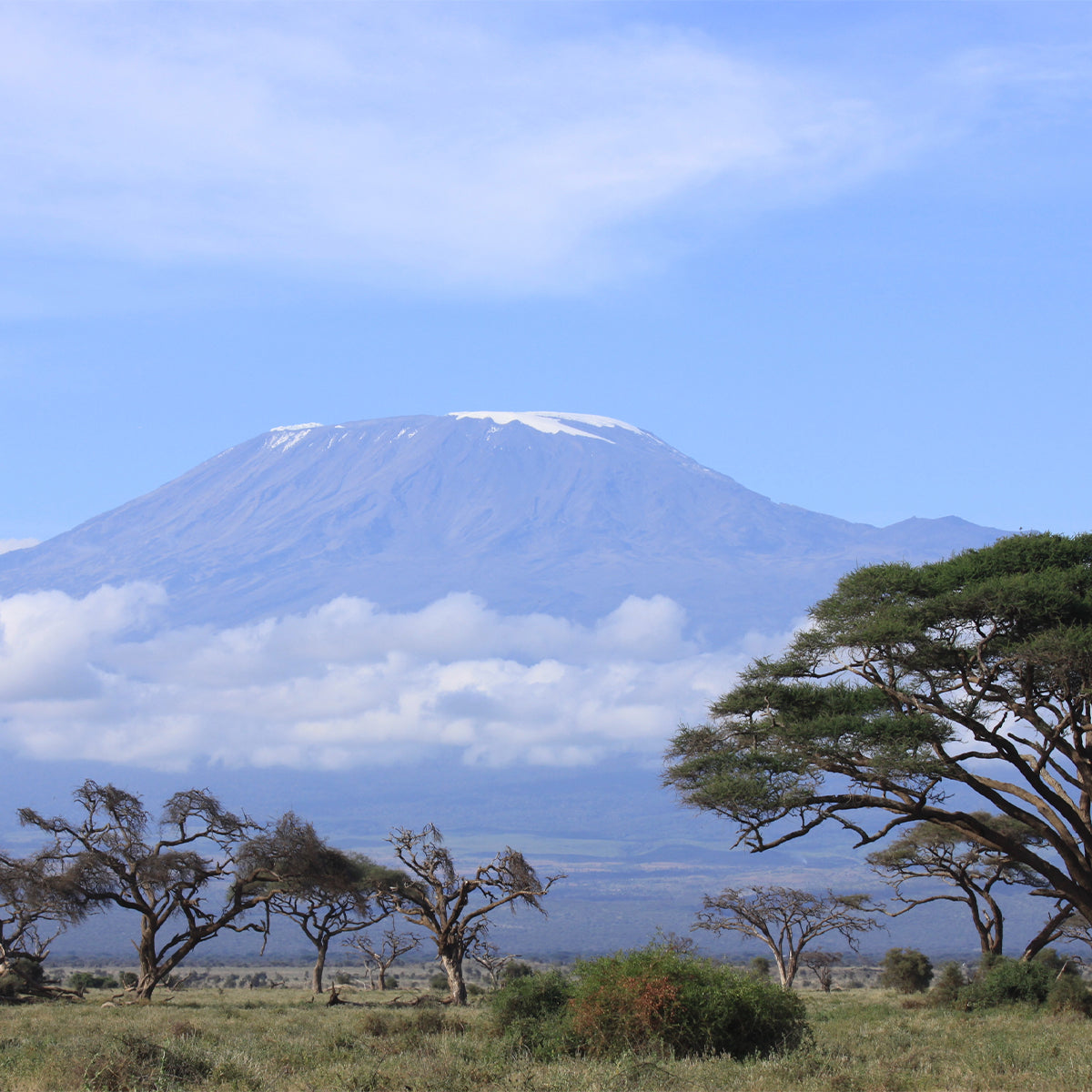
The formation of Tanzanite
Five hundred and eighty five million years ago, in the foothills of Mount Kilimanjaro, Mother Nature yielded her most precious of all gems. As testimony to its rarity it remained unknown until 1967 when it was discovered at what is still the world's only known source – Tanzania.
Significant tectonic plate activity and intense heat formed Mount Kilimanjaro, and in this process, the Mozambique Orogenic Belt (one of the most mineral-rich places on Earth), was formed as well. It is believed that it was during this process that rough tanzanite was formed. The process is known as regional metamorphism, when tectonic plates collide with one another, the igneous rocks (rocks formed through the cooling and solidification of magma / lava) of each tectonic plate are morphed into one another by means of extreme pressure.
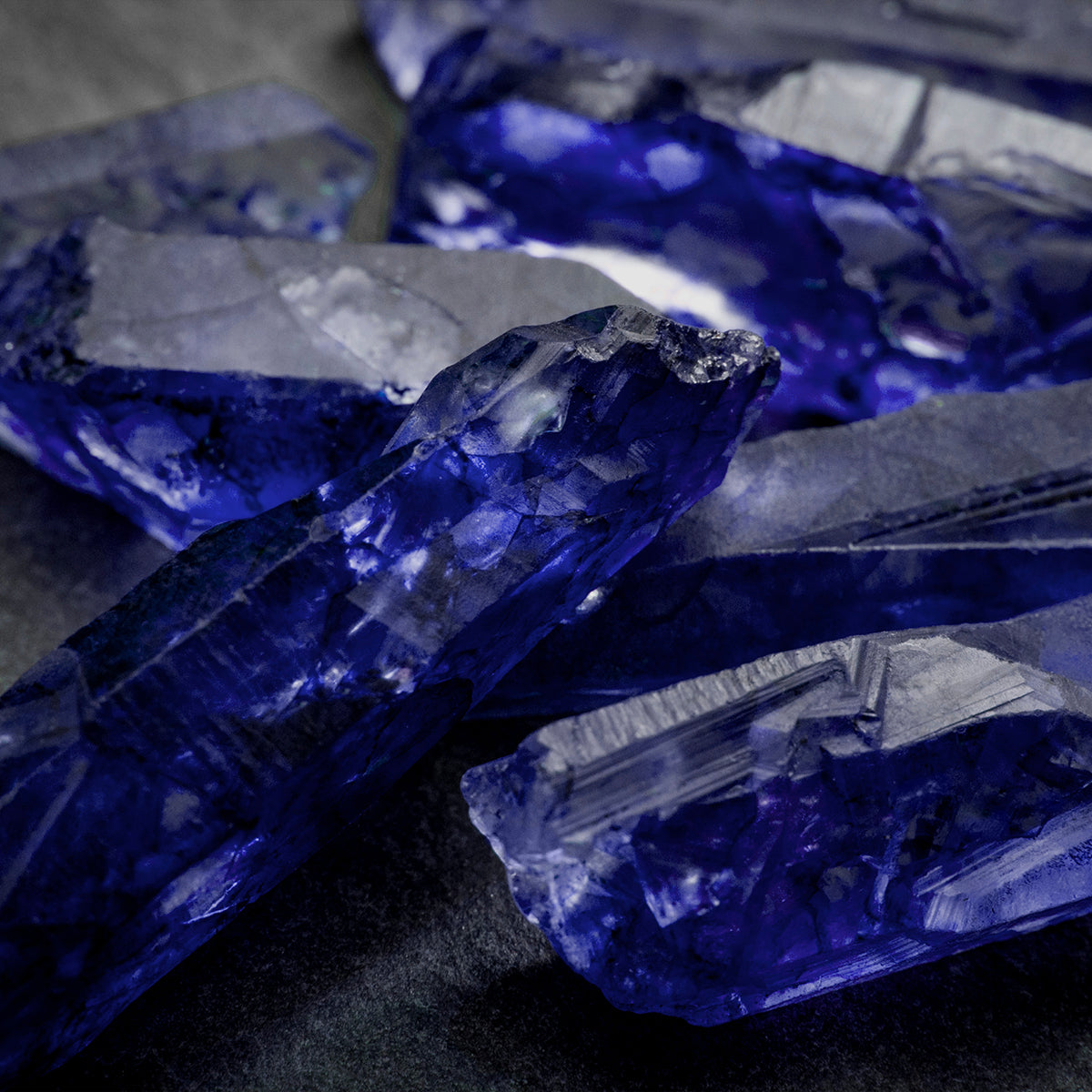
The rocks reach near melting-point, and when this happens, they produce beautiful crystal structures. In this process, gems are formed, essentially, from the coming together of two plates. Each of the two plates can contain a variety of different minerals, and because of this, combinations that are specific to one area, may occur. This explains why tanzanite is only found in one area in the world. The morphing together of two tectonic plates in this specific area of Tanzania resulted in a particular mix that has not been discovered anywhere else in the world.
The conditions that created the tanzanite deposit at the foothills of Mount Kilimanjaro are thought to be so unique, that geologists believe the chances of another batch of tanzanite being created are only about one in one million.

Among the local people of Tanzania, various stories and myths exist as to how this precious gem came about. It is popularly believed that tanzanite was formed by an act of God, when he used lightning strikes to set the surrounding hills alight.
After the fires burnt out and the earth cooled down, the rocks deep inside the earth turned blue. The gem is also believed to carry unique spiritual properties, with local Tanzanian people believing that tanzanite heightens spiritual growth.
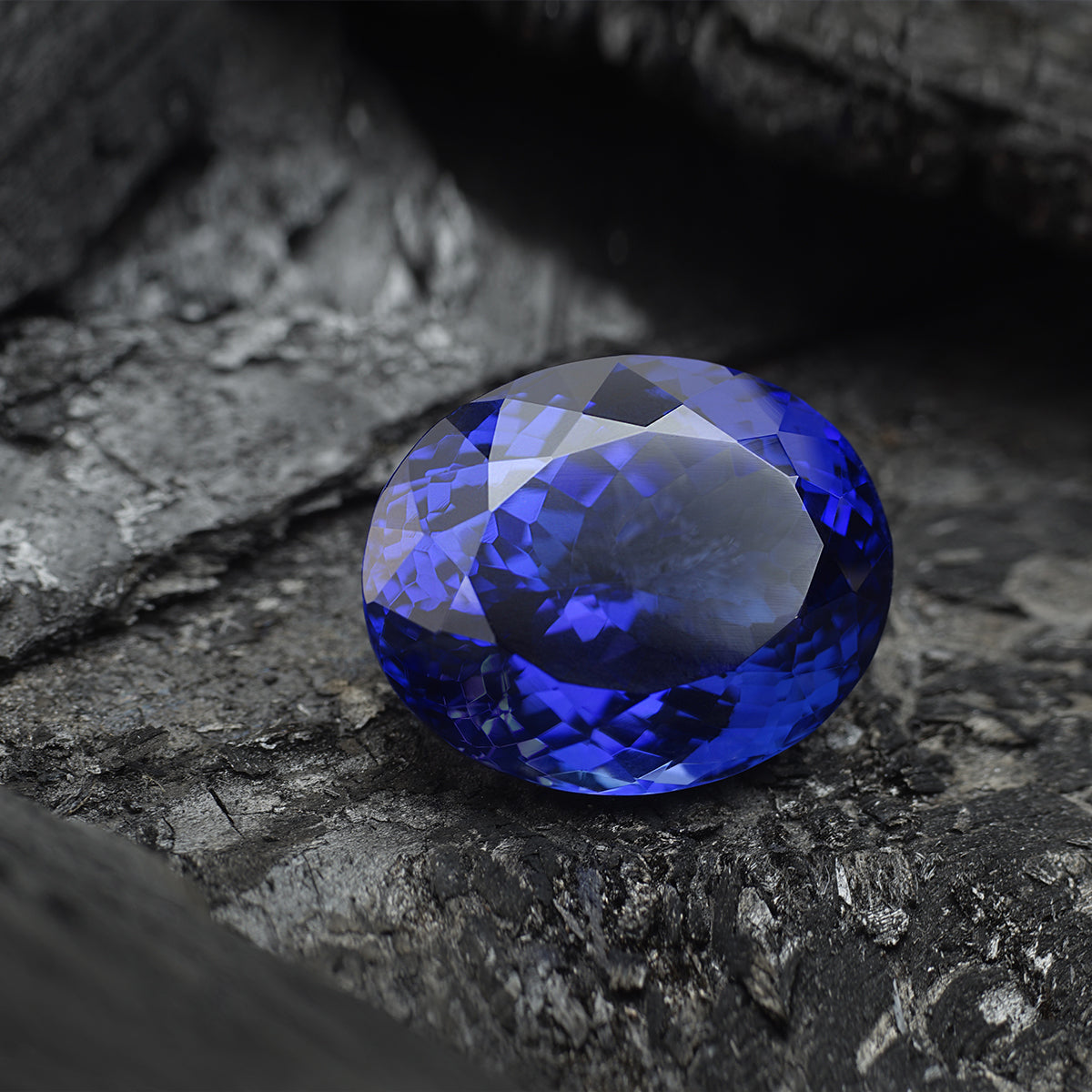
Attributes of tanzanite
- Rarity: Tanzanite’s only known source in the world is a 4km strip of land near Mount Kilimanjaro, northern Tanzania. This single, limited source renders tanzanite at least a thousand times more than diamonds. With only one known source to date, it is predicted that within the next 10 – 12 years no more gem-quality tanzanite will be found.
- Colour: Tanzanite is uniquely trichroic. This means that in its rough form, it radiates three different colours from each of its crystallographic axes: blue, violet and burgundy. Once cut and polished, tanzanite ranges from electric violets to vibrant blues, deep royals and rich indigos. The color of Tanzanite is strongly related to the presence of vanadium and titanium in its crystallographic structure.
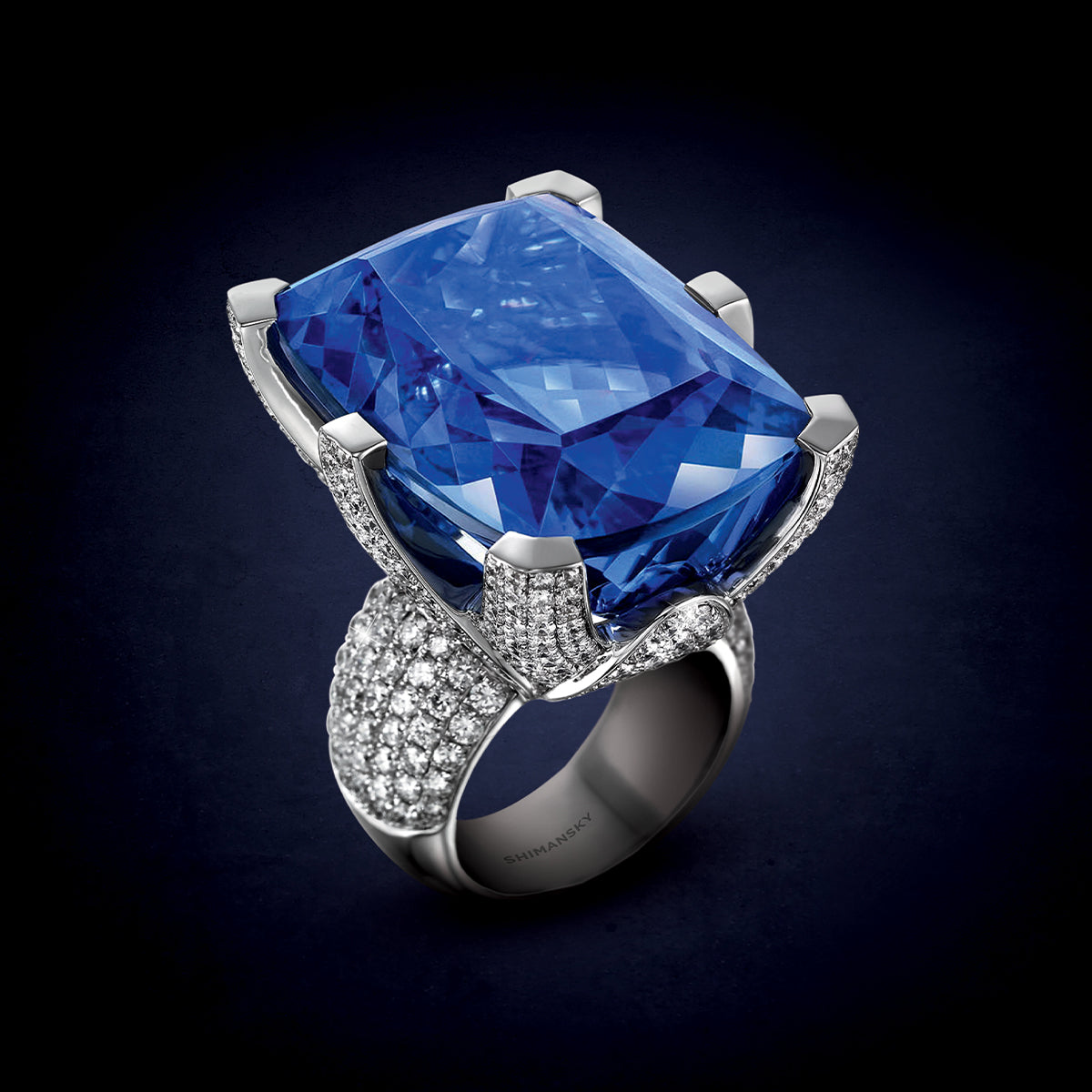
- African mystique: Its geology is so unique that the chances of tanzanite occurring elsewhere in the world are unlikely. Tanzanite’s exclusively African heritage and the alluring narrative of its discovery have proved to be a unique selling feature. Tanzanite jewellery is a particularly attractive investment for foreigners visiting the African continent, as it allows them to take home, something that is uniquely African.
- Investment value: There is no other investment that will yield as great a return as investing in tanzanite of the highest quality. It is more likely to increase in value as supply gets less and demand increases.
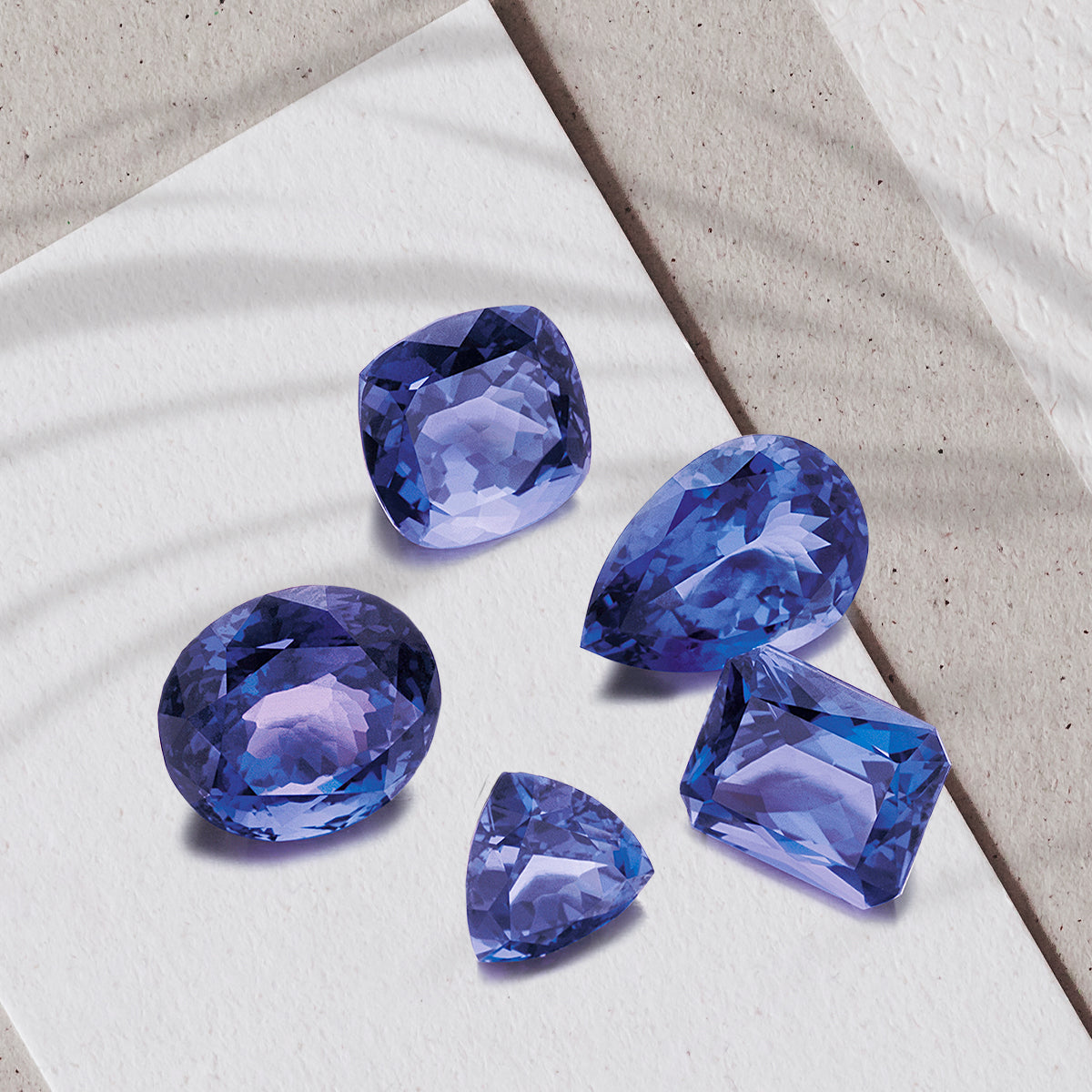
Shaping beauty
From the classic round brilliant cut, trilliant, oval to a romantic heart shape Tanzanite, Shimansky cut and polish any shape you desire. Ranging from 1ct up to 100ct, to be set in a unique jewelry design of your choice or as an investment gem for your collection.
The most important factor in gemstones is the color and its even distribution that can only be achieved through the art of rough planning, cutting and polishing that maximizes the gemstone's full potential.

The origin of tanzanite
Tanzanite’s only known source in the world is a 4km strip of land near Mount Kilimanjaro, northern Tanzania. This single, limited source renders tanzanite at least a thousand times more than diamonds. With only one known source to date, it is predicted that within the next 10 – 12 years no more gem-quality tanzanite will be found. Its geology is so unique that the chances of tanzanite occurring elsewhere in the world are highly unlikely. Because of this scarcity, tanzanite jewellery is extremely sought-after and valuable.
Tanzanite was brought into the commercial market place by Manuel D'Souza, a tailor by profession and prospector by passion, who incorrectly identified it as a sapphire. In years to follow, Tanzanite found its way to the GIA (Gemological Institute of America) in New York, who analysed the gem and identified it as a variety of the mineral zoisite.
Though there are various accounts of how tanzanite was first discovered in Tanzania, the most credible, and widely accepted story, started with an Arusha tailor named Manual d’Souza. On July 7th 1967, d’Souza discovered a cluster of transparent blue stones laying on the ground near the foothills of Mount Kilimanjaro, which he immediately mistook for sapphires.
He presented them to an acquaintance, who suggested they have the stones tested for hardness, in order to identify their compounds. The test ruled out the possibility of sapphires, as the stones were much softer than a typical sapphire. They were then misidentified as peridot, and later as dumortierite. The gems appeared to be something entirely new, unknown to the gemological world.
The gems discovered by d’Souza were sent off to the GIA (Gemological Institute of America), where expert gemologists identified them as a variant of the stone zoisite. At around the same time, the correct identification of de Souza's discovery was made by Ian McCloud, a Tanzanian government geologist in Dodoma, with later confirmations from Harvard, the British Museum, and University of Heidelberg.

Shortly after de Souza's discovery, he attempted to register his mining claim with the Tanzanian Government’s Mines & Geology Department, but he soon discovered that other prospectors had already registered zoisite mining claims before he managed to change the name of the gem on his original claim registration. During this period, another popular name for this variety of zoisite was "Skaiblu," a Swahili-language interpretation of the English term "Sky Blue."
The short strip of land at the foothills of Mount Kilimanjaro soon became covered in mines as people were hoping for their share in this new discovery. As a result, d'Souza was unable to maintain control over his mining claim. In 1971, the Tanzanian government took control of the mines and turned them over to the State Mining Corporation in 1976.
Tanzanite first became popular commercially when Henry Platt, the great grandson of Louis Comfort Tiffany, founder of the American jewellery manufacturer Tiffany & Co, fell in love with the gem. He became so excited at the prospect of selling it, that he immediately set about creating a marketing campaign around it, and he was adamant to be the first to bring tanzanite to the jewellery market on a grand scale.
It was Platt who named the gem “tanzanite,” after its country of origin, Tanzania. Platt famously called tanzanite "the most important gemstone discovery in over 2000 years." Seemingly overnight, tanzanite became the most coveted and popular gemstone in the world.
Today, tanzanite rings and other tanzanite jewellery creations are a popular choice not only for investment, but also to wear – the stones offer a unique beauty unachievable by other gems, and with their rich African heritage, they offer foreigners visiting Africa the opportunity to purchase a truly African keepsake.
Shimansky is home to the most beautiful tanzanite rings in South Africa. Sourced directly from the Maasai tribe in Tanzania, only the very best quality gems are chosen for each Shimansky Ayanda Tanzanite jewellery creation. The Shimansky Ayanda Queen of Tanzanite collection comprises a variety of breathtaking rings, pendants and earrings.
He presented them to an acquaintance, who suggested they have the stones tested for hardness, in order to identify their compounds. The test ruled out the possibility of sapphires, as the stones were much softer than a typical sapphire. They were then misidentified as peridot, and later as dumortierite. The gems appeared to be something entirely new, unknown to the gemological world.
The gems discovered by d’Souza were sent off to the GIA (Gemological Institute of America), where expert gemologists identified them as a variant of the stone zoisite. At around the same time, the correct identification of de Souza's discovery was made by Ian McCloud, a Tanzanian government geologist in Dodoma, with later confirmations from Harvard, the British Museum, and University of Heidelberg.

The mining of tanzanite
With an established direct-to-mine relationship, Shimansky sources top quality certified tanzanite direct from the Maasai tribe in Tanzania, contributing to their sustainability and affording a unique opportunity to select the latest tanzanite mined. These beautiful, top quality gems are transformed into stunning Shimansky tanzanite jewellery creations, forming part of the Ayanda Queen of Tanzanite jewellery collection.
Since the discovery of tanzanite in 1967, it is estimated that two million carats of tanzanite were mined in Tanzania before the Tanzanian government nationalised the mines.

Only two kilometres wide and four kilometres long, the tanzanite mining area was divided into four sections by the Tanzanian government in 1990. These sections are known as Blocks A, B, C and D and have been allotted to different mining groups. The A-Block and C-Block are reserved for foreign investment and large operators, while B and D can be mined by locals.
Tanzanite is found in sausage-shaped formations, called boudins. Boudins are pegmatitic veins that have become stressed and have broken into smaller pieces. Tanzanite stones are found in small pockets inside the boudins. Not every boudin will produce tanzanite, and many that do, contain low-grade material not useful for jewellery.
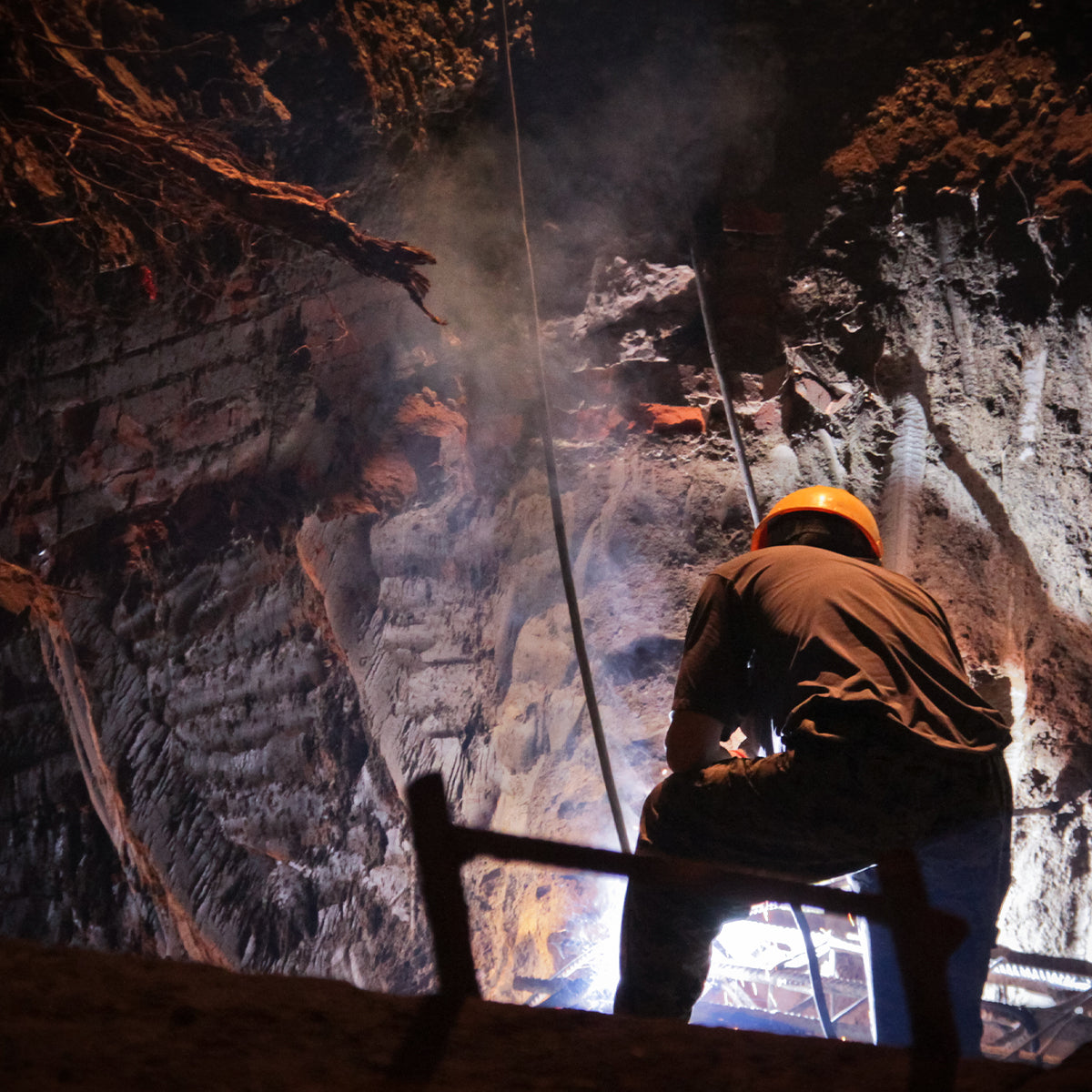
Initially, tanzanite was easily collected from the surface, but scavenging mining didn’t last long and pits and tunnels quickly took preference. Geological testing has shown that tanzanite layers exist down to 200 meters below the ground. As mining levels drop deeper, increasingly sophisticated infrastructure is required to access the tanzanite. World-class infrastructure is put in place to secure the shafts, provide air supply and ventilation, watering and dewatering, to ensure the safety of the mine workers, and ensure that the tanzanite can be extracted safely and productively.
Processing and sorting takes place on-site. Rough tanzanite is sorted both manually and using a fully automated optical sorting/primary grading system - a world first in the coloured gemstone industry. There are various steps in the sorting process.
The tanzanite is then pushed against a lap (a spinning wheel) to polish the stone. Polishing gives the stone its final facets and it is during this stage that the gem comes to life. The process requires a huge amount of skill and concentration, and it is this part of the process where the stone is given its grandeur. The gem is meticulously checked by the cutter after each facet has been polished; he inspects each facet closely before moving onto the next one. After being polished, the tanzanite is ready to be sent to the Tanzanite International grading facility, where its colour, clarity, cut and carat weight will be graded. Once the grading is complete, the gem will either be sold as a loose stone, or it will be set in a beautiful jewellery creation.
Tanzanite is a unique gem, and requires experience, skill and attention to detail in the cutting and polishing processes. To achieve the optimum cut, the cutter must give the gem his undivided attention, and as a result, it can take days to cut and polish a single stone. The result, however, is worth the effort. Tanzanite jewellery is not only a great investment, but is absolutely beautiful to wear. When buying tanzanite in South Africa, select a stone from a reputable jeweler that has been cut and polished to maximise its beauty and reveal its true potential.
Tanzanite is found in sausage-shaped formations, called boudins. Boudins are pegmatitic veins that have become stressed and have broken into smaller pieces. Tanzanite stones are found in small pockets inside the boudins. Not every boudin will produce tanzanite, and many that do, contain low-grade material not useful for jewellery.

Firstly, the gems are picked from the shaft, after which they are taken to the sorting house where they are cleaned and weighed. Unwanted materials (ie. non-gem matter) are removed from the gems, and then the cobbing process begins. The gems are cobbed and graded so that they can be divided into various groups. Gems of good quality are taken away for carat, clarity and colour grading, while others are taken away to be sold as they are, and the off-cuts or “waste” are collected to be sold locally. Once all the grading and sizing procedures have taken place, the gems are packed and ready to be sold.
Around 70 000 people are supported and employed by the tanzanite mining, cutting and trading industry, worldwide. Buying tanzanite in South Africa and other countries, from a reputable jeweller, supports the Tanzanian economy, and allows buyers to invest in something truly spectacular – a gem so precious and rare, that even the most striking sapphires struggle to compete with its beauty.
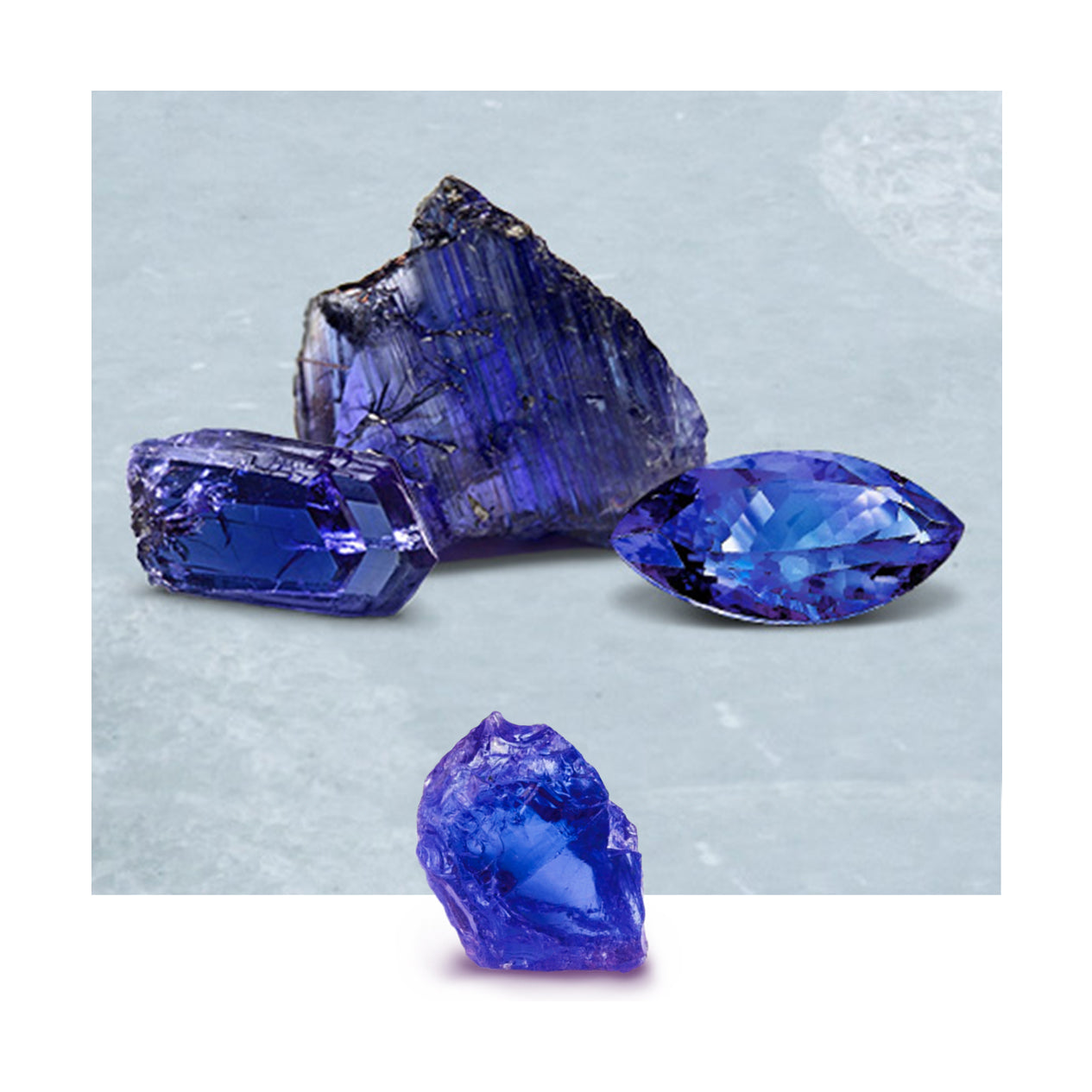
Cutting & polishing of tanzanite
In the rough, tanzanite shows potential thanks to its attractive bluish colour, but once cut and polished, the gem is brought to life, displaying magnificent fire, brilliance and scintillation. Cut by a master craftsman, each single facet of the tanzanite gem is shaped by hand. When you purchase a tanzanite ring, tanzanite necklace, or tanzanite earrings from Shimansky, you can be certain that only the highest quality stones have been used, and that each stone has been cut and polished to maximise its beauty. All of Shimansky’s tanzanite is sourced direct from the mine and is cut and polished in-house in the Shimansky factory with the most cutting-edge technology and highly skilled craftsmen, after which it is set and transformed into breath-taking tanzanite jewellery creations.
Cobbing - After mining, the non-gemstone material is removed from the tanzanite with small, sharp hammers. This process is known as cobbing.
Initial Grading - The cobbed tanzanite is weighed and sorted into groups based on colour and size in order to determine value. Through a vigorous and necessary processing, optical and manual sorting system, the rough tanzanite gems are prepared for the stages that follow.
Cutting & Polishing - Shimansky’s highly skilled craftsmen examine each tanzanite and determine which shape and cut is best for the gem. The planning process is of utmost importance, as the cutter needs to select a cut that will yield the most brilliance, and bring out the stone’s full potential. A wrong cut can have a massive negative impact on the value of the gem. A ‘window’ is polished into the preformed tanzanite in order to check the tanzanite’s clarity. Before the tanzanite can be cut, it is divided into desired, marked pieces, a process in which markings are made against the planes that the rough stone needs to be sawn or cut.
These preformed tanzanite stones are attached to a dop stick with hot wax, which holds the stone in place for the spinning wheel, where the “bruting” process takes place. During this process, the corners of the rough stone are rounded, and the tanzanite’s girdle is formed (the girdle is the surface which is formed around the thickest part of the stone). Another tanzanite stone, set in a “bruting stick,” is used to gradually round off the corners of the rough stone until it is perfectly round at its thickest part. The dop stick is attached to the machine at precise angles, to achieve perfect symmetry and correct angles. The tanzanite is then cut into the desired shape. A quality check is done at the end of the bruting process to ensure the tanzanite meets the criteria to move onto the polishing process.
The tanzanite is then pushed against a lap (a spinning wheel) to polish the stone. Polishing gives the stone its final facets and it is during this stage that the gem comes to life. The process requires a huge amount of skill and concentration, and it is this part of the process where the stone is given its grandeur.
The gem is meticulously checked by the cutter after each facet has been polished; he inspects each facet closely before moving onto the next one. After being polished, the tanzanite is ready to be sent to the Tanzanite International grading facility, where its colour, clarity, cut and carat weight will be graded. Once the grading is complete, the gem will either be sold as a loose stone, or it will be set in a beautiful jewellery creation.
Tanzanite is a unique gem, and requires experience, skill and attention to detail in the cutting and polishing processes. To achieve the optimum cut, the cutter must give the gem his undivided attention, and as a result, it can take days to cut and polish a single stone. The result, however, is worth the effort. Tanzanite jewellery is not only a great investment, but is absolutely beautiful to wear. When buying tanzanite in South Africa, select a stone from a reputable jeweler that has been cut and polished to maximise its beauty and reveal its true potential.
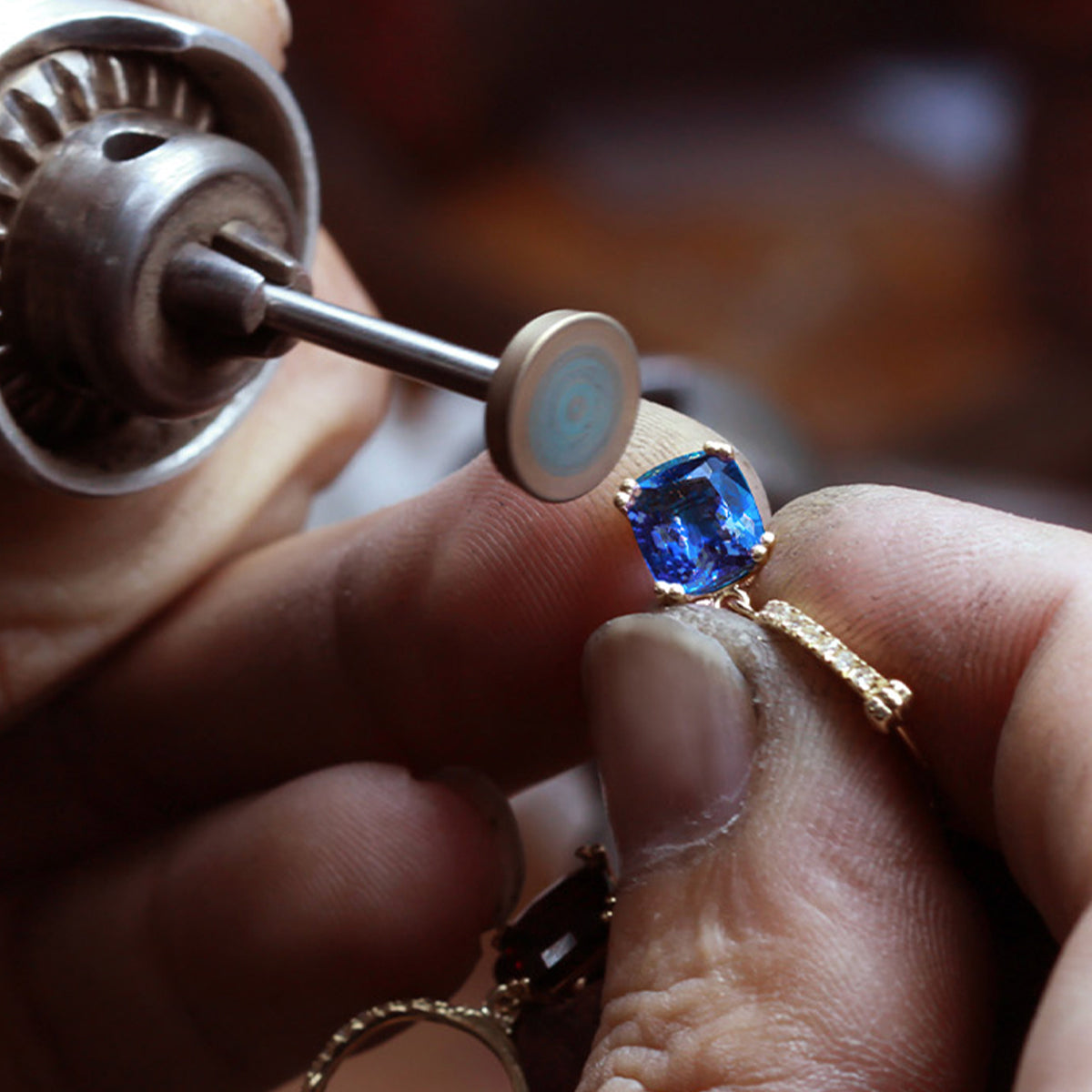
Tanzanite Setting
Tanzanite is a unique and beautiful gem that comes to life when set in a pair of earrings, a bracelet, a necklace or a ring. Exceptionally beautiful and unique, tanzanite jewellery has become sought-after all over the world. However, it is important to note that not any jeweller can work with this unique gem. On the Moh’s Scale of Hardness, tanzanite is relatively soft with a hardness of 6.5 - 7. This is much softer than, for instance, a diamond, which has a hardness of 10.
This means that tanzanite is a stone with lower durability than diamonds and many other gems, and it is more prone to chipping than most traditional gemstones. As a result, great care must be taken by the jeweller who sets the stone, as well as by the person who wears the final jewellery creation. This is especially true when the tanzanite gem is worn in a ring, as it is more likely to get bumped or knocked during everyday activities.

In addition to being vulnerable to damage when worn, tanzanite is also vulnerable when set in a jewellery creation. Tanzanite’s inherent division means that its structure is sometimes under threat during the setting process. It is very sensitive to heat, or sudden changes in temperature, which is why equipment like jewellery steam cleaners are best avoided around this precious gem. If exposed to changes in temperature, the stone could easily fracture, which affects not only its beauty, but also its value. In addition, tanzanite’s cleavage also makes it vulnerable to fracturing if cleaned in an ultrasonic cleaner.
Great care must be taken when working with tanzanite jewellery. If a jeweller is inexperienced in working with tanzanite, the stone can be greatly damaged during the setting process. When buying tanzanite in South Africa, be sure to choose a reputable jeweller with experience in working with tanzanite. The Shimansky craftsmen have over two decades of experience working with this phenomenal gem.
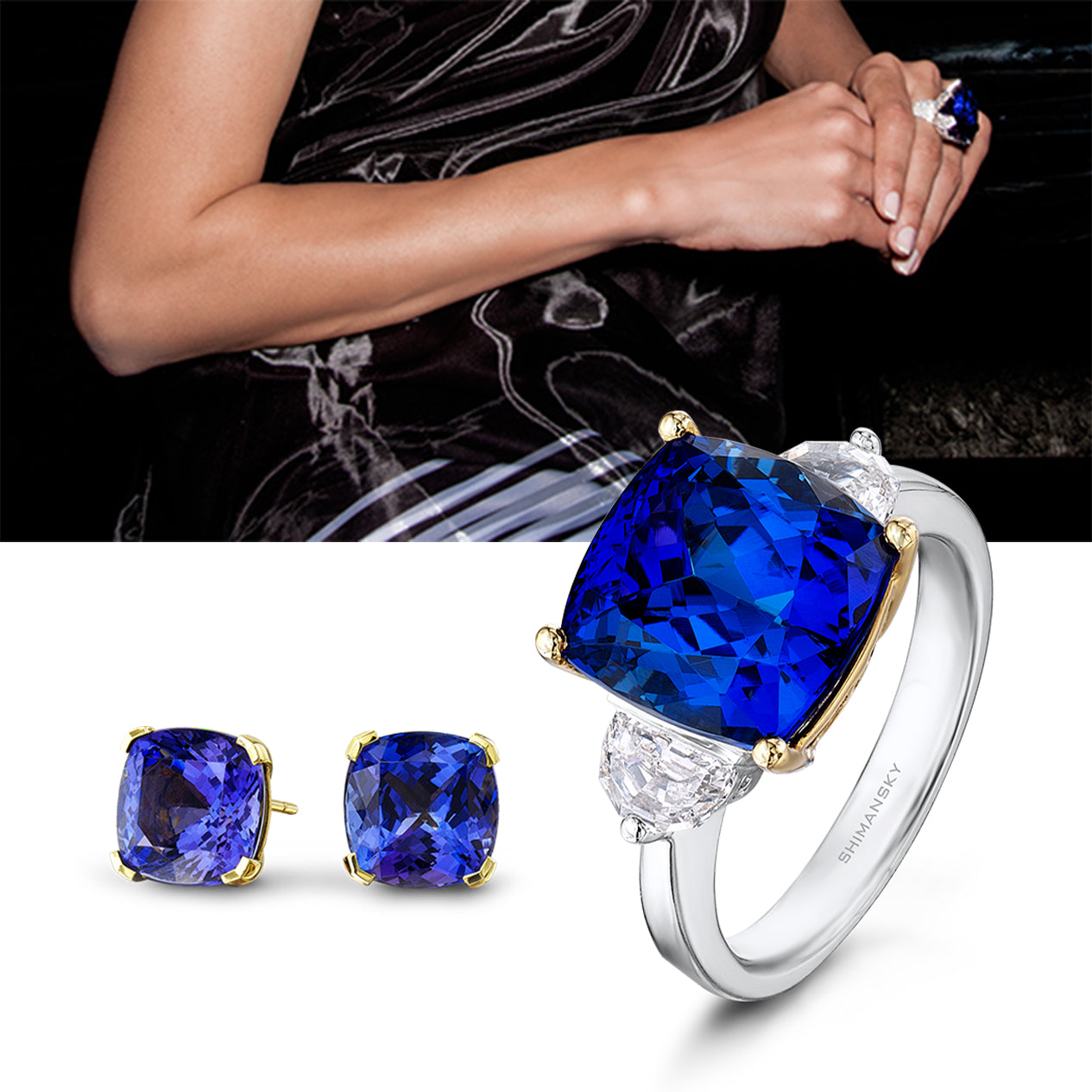
Shimansky sources only the finest quality tanzanite straight from Tanzania. Great care is taken when planning each stone’s cut and polish – tanzanite has incredible potential and in order to maximise its beauty and reveal its brilliance, cutters examine the stone carefully before deciding upon a cut that would best suit that particular stone. Using cutting-edge technology in conditions carefully set out for this unique gem, the stone is carefully sculpted and brought to life. Shimansky jewellers rely on years of knowledge and experience with each tanzanite setting.
Tanzanite already appreciates in value every year, but once supplies begin to run low, the gem is expected to significantly increase in value. Experts believe that once the supply of tanzanite is exhausted, it will reach an all-time high value, and prices of the gem are expected to rise dramatically. Like in all industries, prices are affected by supply and demand. The demand for tanzanite continues to rise, but the supply is slowly decreasing.
Once tanzanite is depleted, there will be no more first time owners of this precious gem, and buyers hoping to acquire their very own tanzanite stone or tanzanite jewellery creation will have to be willing to spend a bit more than they currently would. As a result, tanzanite rings, earrings, necklaces and bracelets are expected to become precious family heirlooms (although in many cases one can say that they already are!).
Because of the decreasing availability, buying tanzanite in South Africa is considered a very good investment. Not only does it appreciate, and is likely to fetch a much higher price in the future than it does now, but it is also a unique gem to pass down to future generations.
TANZANITE JEWELLERY
Want to learn more about Tanzanite
Click to explore 'Investing in Tanzanite' and discover valuable insights that can guide you towards making informed decisions about this unique gemstone as a worthy investment. Alternatively, satisfy your curiosity with '15 Interesting Facts' about Tanzanite, unraveling the intriguing details that make this gemstone truly exceptional.




